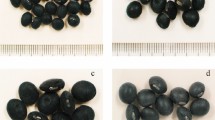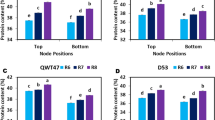Abstract
We obtained new hybrid soybeans (Hybrid) with different seed coat colors such as green (Hybrid-GR), brown (Hybrid-BR), yellow (Hybrid-YE), and black (Hybrid-BL), by hybridizing β-carotene-enhanced soybeans (BCE; Glycine max L.) containing the phytoene synthase-2A-carotene desaturase gene and wild soybeans (Wild; Glycine soja). This study aimed to analyze metabolic changes between Hybrids using comprehensive metabolite profiling of BCE, Wild, and four Hybrids. The composition and content of metabolites varied based on the type of soybeans. Multivariate and metabolic pathway analyses showed distinct differences among the six soybeans. Hybrid-GR showed accumulation of isoflavones and tocopherols, whereas Hybrid-BL had higher contents of anthocyanins and carotenoids than other Hybrids. The projection to latent structure analysis showed that the most important contributors in enhanced free radical scavenging activity were phenolic compounds such as anthocyanins and flavonoids and isoprenoids such as carotenoids, tocopherols, and phytosterols, assessed using 2,2-diphenyl-1-picrylhydrazyl and 2,2´-azino-bis(3-ethylbenzothiazoline-6-sulfonic acid) assays, respectively. Based on these results, Hybrid-GR and Hybrid-BL comprising significant quantities of functional compounds such as isoflavones, carotenoids, and anthocyanins are proposed as new breeding candidates.






Similar content being viewed by others
Abbreviations
- ABTS:
-
2,2´-Azino-bis(3-thylbenzothiazoline-6-sulfonic acid)
- BCE:
-
β-Carotene-enhanced soybeans
- DPPH:
-
2,2-Diphenyl-1-picrylhydrazyl
- GC–TOF-MS:
-
Gas chromatography–time-of-flight mass spectrometry
- GC–qMS:
-
Gas chromatography–quadrupole mass spectrometry
- GM:
-
Genetically modified
- HCA:
-
Hierarchical cluster analysis
- HPLC:
-
High-performance liquid chromatography
- Hybrid:
-
Hybrid soybeans
- Hybrid-GR:
-
Hybrid soybeans with green seed coat
- Hybrid-BL:
-
Hybrid soybeans with black seed coat
- Hybrid-BR:
-
Hybrid soybeans with brown seed coat
- Hybrid-YE:
-
Hybrid soybeans with yellow seed coat
- MOX:
-
Methoxyamine hydrochloride
- MSTFA:
-
N-Methyl-N-(trimethylsilyl)trifluoroacetamide
- PCA:
-
Principal component analysis
- UV:
-
Unit variance
- Wild:
-
Wild soybeans
References
Abidi SL (2001) Chromatographic analysis of plant sterols in foods and vegetable oils. J Chromatogr A 935:173–201
Awika JM, Rooney LW, Wu X, Prior RL, Cisneros-Zevallos L (2003) Screening methods to measure antioxidant activity of sorghum (Sorghum bicolor) and sorghum products. J Agric Food Chem 51:6657–6662
Bursać M, Krstonošić MA, Miladinović J, Malenčić D, Gvozdenović L, Cvejić JH (2017) Isoflavone composition, total phenolic content and antioxidant capacity of soybeans with colored seed coat. Nat Prod Commun 12:527–532
Bustamante MA, Michelozzi M, Barra Caracciolo A, Grenni P, Verbokkem J, Geerdink P, Saf C, Nogues I (2020) Effects of soil fertilization on terpenoids and other carbon-based secondary metabolites in Rosmarinus officinalis plants: a comparative study. Plants 9(7):830
Chen Q, Wang X, Yuan X, Shi J, Zhang C, Yan N, Jing C (2021) Comparison of phenolic and flavonoid compound profiles and antioxidant and α-glucosidase inhibition properties of cultivated soybean (Glycine max) and wild Soybean (Glycine soja). Plants 10(4):813
Cho KM, Ha TJ, Lee YB, Seo WD, Kim JY, Ryu HW, Jeong SH, Kang YM, Lee JH (2013) Soluble phenolics and antioxidant properties of soybean (Glycine max L.) cultivars with varying seed coat colours. J Funct Foods 5:1065–1076
Gao S, Lyu Y, Zeng W, Du G, Zhou J, Chen J (2020) Efficient biosynthesis of (2 S)-naringenin from p-Coumaric acid in Saccharomyces cerevisiae. J Agric Food Chem 68:1015–1021
Hyeon HJ, Xu JL, Kim JK, Choi Y (2020) Comparative metabolic profiling of cultivated and wild black soybeans reveals distinct metabolic alterations associated with their domestication. Food Res Int 134:109290
Jung JW, Park SY, Oh SD, Jang Y, Suh SJ, Park SK, Ha SH, Park SU, Kim JK (2021) Metabolomic variability of different soybean genotypes: β-carotene-enhanced (Glycine max), wild (Glycine soja), and hybrid (Glycine max × Glycine soja) soybeans. Foods 10(10):2421
Kim IS (2021) Current perspectives on the beneficial effects of soybean isoflavones and their metabolites for humans. Antioxidants 10(7):1064
Kim JK, Lee SY, Chu SM, Lim SH, Suh SC, Lee YT, Cho HS, Ha SH (2010) Variation and correlation analysis of flavonoids and carotenoids in Korean pigmented rice (Oryza sativa L.) cultivars. J Agric Food Chem 58:12804–12809
Kim EH, Kim SL, Kim SH, Chung IM (2012a) Comparison of isoflavones and anthocyanins in soybean (Glycine max (L.) Merrill) seeds of different planting dates. J Agric Food Chem 60:10196–10202
Kim MJ, Kim JK, Kim HJ, Pak JH, Lee JH, Kim DH, Choi HK, Jung HW, Le JD, Chung YS, Ha SH (2012b) Genetic modification of the soybean to enhance the β-carotene content through seed-specific expression. PLoS ONE 7:e48287
Kim JK, Park SY, Lim SH, Yeo Y, Cho HS, Ha SH (2013) Comparative metabolic profiling of pigmented rice (Oryza sativa L.) cultivars reveals primary metabolites are correlated with secondary metabolites. J Cereal Sci 57:14–20
Kim EH, Lee OK, Kim JK, Kim SL, Lee J, Kim SH, Chung IM (2014a) Isoflavones and anthocyanins analysis in soybean (Glycine max (L.) Merrill) from three different planting locations in Korea. Field Crops Res 156:76–83
Kim JK, Kim EH, Park I, Yu BR, Lim JD, Lee YS, Lee JH, Kim SH, Chung IM (2014b) Isoflavones profiling of soybean (Glycine max (L.) Merrill) germplasms and their correlations with metabolic pathways. Food Chem 153:258–264
Kim TJ, Kim SY, Park YJ, Lim SH, Ha SH, Park SU, Lee B, Kim JK (2021) Metabolite profiling reveals distinct modulation of complex metabolic networks in non-pigmented, black, and red rice (Oryza sativa L.) Cultivars. Metabolites 11(6):367
Kumar V, Rani A, Dixit AK, Pratap D, Bhatnagar D (2010) A comparative assessment of total phenolic content, ferric reducing-anti-oxidative power, free radical-scavenging activity, vitamin C and isoflavones content in soybean with varying seed coat colour. Food Res Int 43:323–328
Lee SM, You YH, Kim KM, Park JJ, Jeong CS, Jhon DY, Jun WJ (2012) Antioxidant activities of native Gwangyang Rubus coreanus Miq. J Korean Soc Food Sci Nutr 41:327–332
Lee KJ, Lee JR, Ma KH, Cho YH, Lee GA, Chung JW (2016) Anthocyanin and isoflavone contents in Korean black soybean landraces and their antioxidant activities. Plant Breed Biotechnol 4:441–452
Lee KJ, Baek DY, Lee GA, Cho GT, So YS, Lee JR, Ma KH, Chung JW, Hyun DY (2020) Phytochemicals and antioxidant activity of Korean black soybean (Glycine max L.) landraces. Antioxidants 9(3):231
Matt P, Krapp A, Haake V, Mock HP, Stitt M (2002) Decreased Rubisco activity leads to dramatic changes of nitrate metabolism, amino acid metabolism and the levels of phenylpropanoids and nicotine in tobacco antisense RBCS transformants. Plant J 30:663–677
Mueller L, Boehm V (2011) Antioxidant activity of beta-carotene compounds in different in vitro assays. Molecules 16(2):1055–1069
Oh SD, Jang YJ, Park SY, Suh SJ, Lee B (2020a) Characterization of hybrid soybean seeds between β-carotene enhanced transgenic soybean and wild soybean. Weed Turfgrass Sci 9:129–139
Oh SD, Jang YJ, Lee ML, Lee K, Suh SJ, Ryu TH, Park SY (2020b) Comparison of the nutritional compositions of hybrid soybean between β–carotene enhanced transgenic soybean and wild soybean. J Korean Soc Int Agric 32:339–347
Park CH, Yeo HJ, Baskar TB, Kim JK, Park SU (2018) Metabolic profiling and chemical-based antioxidant assays of green and red lettuce (Lactuca sativa). Nat Prod Commun 13:315–322
Park YJ, Baek SA, Choi Y, Kim JK, Park SU (2019) Metabolic profiling of nine mentha species and prediction of their antioxidant properties using chemometrics. Molecules 24(2):258
Qin Y, Kweon S, Chung Y, Ha SH, Shin KS, Lim M, Kwon T, Cho HS, Park S, Woo H (2015) Selection of β-carotene enhanced transgenic soybean containing single-copy transgene and analysis of integration sites. Korean J Breed Sci 47:111–117
Qin Y, Park SY, Oh SW, Lim MH, Shin KS, Cho HS, Lee SK, Woo HJ (2017) Nutritional composition analysis for beta-carotene-enhanced transgenic soybeans (Glycine max L.). Appl Biol Chem 60:299–309
Sánchez-Rabaneda F, Jáuregui O, Casals I, Andrés-Lacueva C, Izquierdo-Pulido M, Lamuela-Raventós RM (2003) Liquid chromatographic/electrospray ionization tandem mass spectrometric study of the phenolic composition of cocoa (Theobroma cacao). J Mass Spectrometry 38:35–42
Shi H, Nam PK, Ma Y (2010) Comprehensive profiling of isoflavones, phytosterols, tocopherols, minerals, crude protein, lipid, and sugar during soybean (Glycine max) germination. J Agric Food Chem 58:4970–4976
Wu H, Deng J, Yang C, Zhang J, Zhang Q, Wang X, Yang F, Yang W, Liu J (2017) Metabolite profiling of isoflavones and anthocyanins in black soybean (Glycine max (L.) Merr.) seeds by HPLC-MS and geographical differentiation analysis in Southwest China. Anal Methods 9:792–802
Yoshida Y, Niki E (2003) Antioxidant effects of phytosterol and its components. J Nutr Sci Vitaminol 49:277–280
Yusnawan E (2016) The diversity of secondary metabolites in Indonesian soybean genotypes. Biodiversitas 17:704–710
Zhang Y, Butelli E, Martin C (2014) Engineering anthocyanin biosynthesis in plants. Curr Opin Plant Biol 19:81–90
Funding
This work was carried out with the support of "Cooperative Research Program for Agriculture Science and Technology Development (Project No. PJ016726)" and “Next-Generation BioGreen 21 Program (Project No. PJ015671)” Rural Development Administration, Republic of Korea.
Author information
Authors and Affiliations
Corresponding authors
Ethics declarations
Competing financial interests
The authors declare no competing financial interests.
Additional information
Publisher's Note
Springer Nature remains neutral with regard to jurisdictional claims in published maps and institutional affiliations.
Supplementary Information
Below is the link to the electronic supplementary material.
Rights and permissions
About this article
Cite this article
Jung, J.W., Oh, SD., Park, SY. et al. Metabolic profiling and antioxidant properties of hybrid soybeans with different seed coat colors, obtained by crossing β-carotene-enhanced (Glycine max) and wild (Glycine soja) soybeans. Plant Biotechnol Rep 16, 449–463 (2022). https://doi.org/10.1007/s11816-022-00759-9
Received:
Revised:
Accepted:
Published:
Issue Date:
DOI: https://doi.org/10.1007/s11816-022-00759-9




